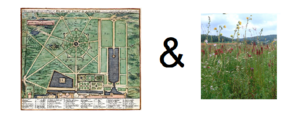Why The Walled Garden and Prairie: Difference between revisions
No edit summary Tag: 2017 source edit |
No edit summary Tag: 2017 source edit |
||
| Line 1: | Line 1: | ||
[[File:Wall&Prairie.png|thumb|left | [[File:Wall&Prairie.png|frameless|thumb|left]] | ||
----This [https://www.goodreads.com/quotes/285437-what-is-in-mind-is-a-sort-of-chautauqua-that-s-the Chautauqua] is a series on what is generally seen as two major incompatible views on how to design, implement and operate information systems. The aim is to explore how both general approaches make sense in different ways and in combination rather than in antagonism. In choosing Walled Garden and Prairie to categorise these two general approaches it might seem that I have a negative bias to one or the other, that really isn't where this is coming from. Walled Garden is often treated as a derogatory term, with hard perimeters, command and control hierarchies and long term planning but its also (in its original use) about providing the right conditions for different plants with different requirements and a structured navigation which allows maintenance, gardening without obstructing or affecting the rest of the Garden. In its way the Prairie might seem without controls, borders, vulnerable and inefficient but it's also resilient because there is no single point of failure and burning it down periodically keeps it healthy. | ----This [https://www.goodreads.com/quotes/285437-what-is-in-mind-is-a-sort-of-chautauqua-that-s-the Chautauqua] is a series on what is generally seen as two major incompatible views on how to design, implement and operate information systems. The aim is to explore how both general approaches make sense in different ways and in combination rather than in antagonism. In choosing Walled Garden and Prairie to categorise these two general approaches it might seem that I have a negative bias to one or the other, that really isn't where this is coming from. Walled Garden is often treated as a derogatory term, with hard perimeters, command and control hierarchies and long term planning but its also (in its original use) about providing the right conditions for different plants with different requirements and a structured navigation which allows maintenance, gardening without obstructing or affecting the rest of the Garden. In its way the Prairie might seem without controls, borders, vulnerable and inefficient but it's also resilient because there is no single point of failure and burning it down periodically keeps it healthy. | ||
Revision as of 16:40, 5 September 2024

This Chautauqua is a series on what is generally seen as two major incompatible views on how to design, implement and operate information systems. The aim is to explore how both general approaches make sense in different ways and in combination rather than in antagonism. In choosing Walled Garden and Prairie to categorise these two general approaches it might seem that I have a negative bias to one or the other, that really isn't where this is coming from. Walled Garden is often treated as a derogatory term, with hard perimeters, command and control hierarchies and long term planning but its also (in its original use) about providing the right conditions for different plants with different requirements and a structured navigation which allows maintenance, gardening without obstructing or affecting the rest of the Garden. In its way the Prairie might seem without controls, borders, vulnerable and inefficient but it's also resilient because there is no single point of failure and burning it down periodically keeps it healthy.
If you want to think of these two views as being 'Enterprise Architecture' on the one hand and 'Startup Scrum like Good Enough for Now' on the other then that's fine so long as you also think about how each view can inform and be integrated into the other. Its that I'd like to describe.
The Chautauqua will meander through the current practices and arguments using this metaphor. They're abstractions and like all abstractions leaky. But we won't worry about that the metaphor will stay useful. But why Chautauqua?
When I was around 18* my local library in Maghull got a copy of Zen and the Art of Motorcycle Maintenance which had just been published. It was in the small Philosophy section which along with obscure foreign authors I used to backfill my education like a magpie and the picture on the back of a low slung motorbike with Pirsig and his son doing the thousand mile stare in monochrome was as shiny a book as I'd seen. Pirsig's peeling away of the layers of Classical and Romantic aspects and exposing Quality as the mutually supporting and unifying glue has stayed with me since. That and the anecdotes around engineering and writing that I'll repeat with the dole regularity of an old fart. Pirsig calls his book a Chatauqua from the travelling circus of educational talks and demonstrations of the 19th Century, a wagon train of TED Talks. That seems to describe what I'm intending to do and its all the more relevant (to me at least), that it was last year (2017) that Pirsig died.
Whether he'd enjoy or approve it though I don't know.
- [Walls and Trust Nothing] - [Interfaces All the Way Down]
*In writing this I was convinced that I was around 15 when I read this but the Universe I appear to be in at the moment has it in 1974 when I was 18. I don't think this is materially a difference to anyone else but its one of those jarring hillocks that you come across between your personal history of the world and its 'objective' truth.^
ORCID  [https://
orcid.org/0000-0002-3617-0891 orcid.org/0000-0002-3617-0891]
[https://
orcid.org/0000-0002-3617-0891 orcid.org/0000-0002-3617-0891]